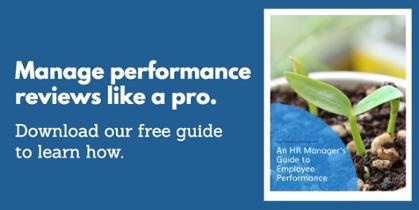![]()
In past articles, we’ve discussed the importance of having ongoing discussions about employee performance instead of a single, loaded performance review every year. Providing more regular feedback allows employees to grow and improve more consistently, and to stay engaged in their work. It also gives managers more opportunities to familiarize themselves with their reports’ strengths, and to coach them so they can produce better outcomes that benefit the whole team.
If your company has traditionally relied on a single annual review, the move to more a ongoing performance improvement process might come with some confusion or pushback. Employees who are used to going all year without any constructive feedback may feel under attack when they start to hear from managers more often. Managers who are not comfortable providing guidance, or who tend to focus their time on other tasks, may resist the increased people management responsibilities.
But joining the forward-thinking companies that have abandoned traditional annual review processes for a more ongoing approach is worth the effort. Increased engagement and stronger relationships between colleagues are key to building a more productive and positive workplace culture. When managers know their employees individually, they can create goals that reflect each person’s unique strengths and challenges, and honor their personal and career goals. As a result, burnout and turnover should decrease, and workplace satisfaction should increase.
So how can you set your team up for success with this shift in processes? Here are some best practices to keep in mind to help make the change go more smoothly:
Communicate your expectations up front
In collective and individual conversations leading up to the start of your new ongoing improvement initiative, explain the reasons you’re making the change. Sell your team on the positive impact you expect to see, and let them know they shouldn’t take any increased critiques of their work personally. Reassure them that this move is meant to help improve their experience as an employee as much as it is to increase productivity.
In the first conversation with each employee, managers should establish a baseline. In which areas is this employee already excelling? Where are their skills less developed? What are their own goals for their job performance?
Managers and employees should use the answers to these questions to set short-term (the next month or so) and long-term (within the next year) goals. Before the end of the conversation, managers should set a time for the next short meeting to check in on progress toward long-term goals, and to set additional short-term goals.
Use teachable moments as they arise
Letting employees’ errors go without comment is not useful to the employee or your company. Just making a note of them to put in the next performance checkin is also not particularly helpful, especially if there’s a possibility for the incorrect work behavior to become a habit. Managers should train themselves to address situations as they arise in order for the employee to grow from the experience.
Starting to have more frequent conversations about job performance, especially when they’re critical, can be uncomfortable at first. A culture of continuous improvement isn’t built overnight, and everyone will have some awkward experiences to learn from. Managers will have to learn how challenge employees in a way that is non-judgemental and focused on individual tasks. Employees will need to adjust to having regular coaching experiences, and learn not to take criticism personally. If everyone can commit to working through these hiccups, the results should speak for themselves before too long.
Get feedback on the process
This is where the work of improving company culture turns into metawork. It’s not enough to gather and provide feedback to individuals and teams; the actual process itself needs to be evaluated. Company leaders should take the temperature of the managers beneath them frequently to see whether the process is improving outcomes, and where it needs to be reworked. In turn, managers need to check in with employees to see how they’re feeling about more regular performance conversations.
Process feedback doesn’t have to be a separate conversation; it can be folded into existing conversations. It’s just a matter of asking a few additional questions when talking to colleagues about their progress and performance. Employees and managers should feel comfortable being honest about their frustrations with the change, and managers should take this feedback into account. Factors like tone of voice, word choice, and delivery can be the difference between an uplifting, engaging conversation and one that negatively affects morale.
As with any sweeping organizational change, the bigger the group of people involved, the more room there is for error and confusion. Changing performance reviews from an annual conversation to a series of ongoing discussions will be an easier task in a small company than in a large one with entrenched processes. Be patient with everyone’s concerns, and keep managers and employees focused on the end goal: a positive workplace that regularly honors each person’s contributions and encourages them toward their professional and personal goals.

